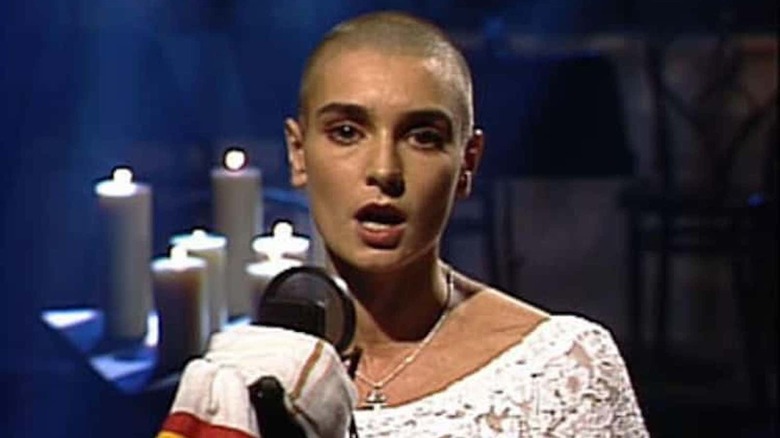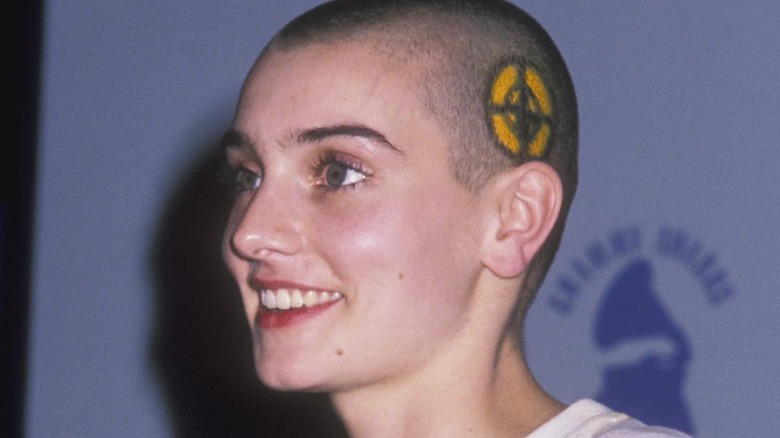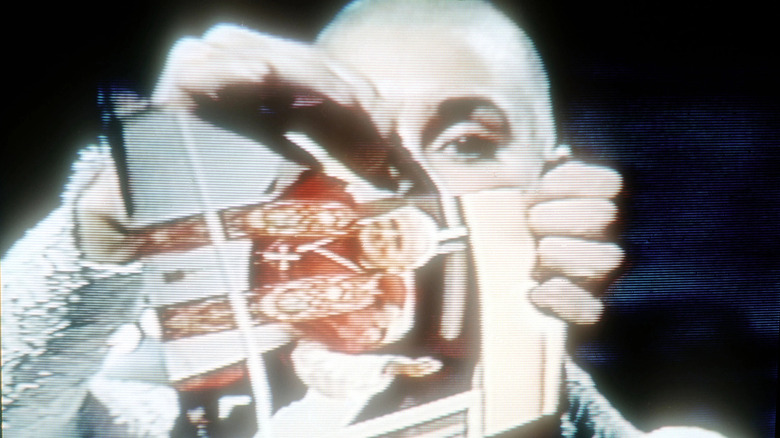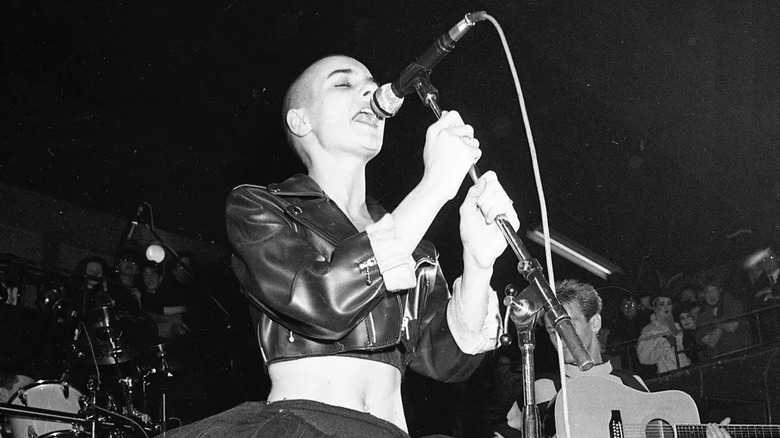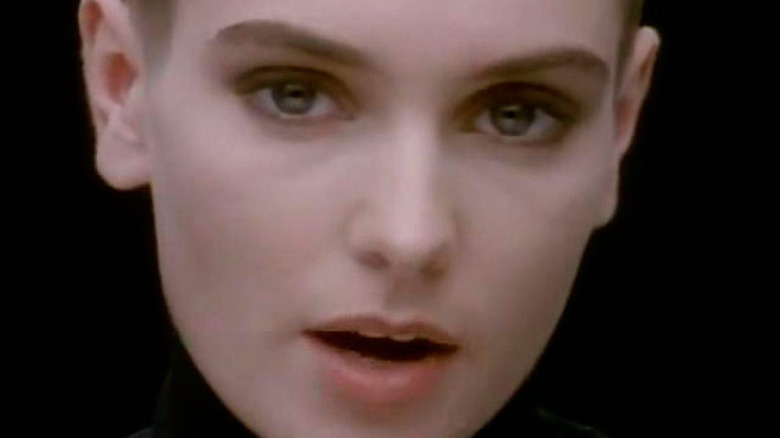Decades Later, Sinéad O'Connor's SNL Performance Is One Of The Bravest Acts In TV History
I remember her hands trembling. They did not tremble. She was not afraid. She was too fired up, too righteous, too right to know fear in that moment.
My memory is tainted by the ensuing smear campaign, a campaign that did not end until today, when Sinéad O'Connor died at the infuriatingly young age of 56 – and I'm probably a fool to believe this denigration will cease just because she's not around to defend herself anymore. I've never seen a popular musician face such unremitting scorn. Not even close. But O'Connor — contrary to the narrative seared into our psyches by a media that could not bear her scorched-earth declaration that the Catholic Church is, charitable works be damned, a factory of institutionally abetted child abuse — never stopped speaking her truth. That continues to be our truth and our shame.
That she did so with a shaved head, which spit acid in the face of conventional beauty standards for women at the time, did her no favors. Hell, being a woman was reason enough to castigate her. Looking that way, being that way, and evincing the temerity to shred a picture of Pope John Paul II on "Saturday Night Live" in the midst of what could then be considered an ideologically charged election year (it feels like a snowball fight 31 years later) placed her in the crosshairs of conservatives looking for an animating issue to kill Democratic presidential candidate Bill Clinton's momentum. The majority of the left (which lacked a noisy progressive faction), eying an electoral college victory in November, wanted no part of her crusade.
The list of supposed allies who abandoned her was long. Her supporters were too few and too inconsequential/timid to deflect the vitriol hurled her way.
So O'Connor took the heat alone.
O'Connor meets the grunge era
October 3, 1992. A dozen or so nerds had huddled in the mod area of Hoover House at Ohio University to watch Tim Robbins host "Saturday Night Live." He was promoting his sadly prophetic mockumentary "Bob Roberts," so even though the show was starting to sputter after its 1986 resurrection — via a cast led by Dana Carvey, Phil Hartman, and Jan Hooks — there was a hint of danger in the air. Throw O'Connor into the mix and it felt faintly like a throwback to the show's troublemaking heyday.
But where was O'Connor artistically? I was a freshman who'd moved from one small college town to another. Musically, grunge and hip-hop were my intoxicants at the time: Nirvana, Pearl Jam, Dr. Dre, Pete Rock & CL Smooth, and so on. I was political. I was the white kid who saw "Do the Right Thing" and went straight home to read "The Autobiography of Malcolm X." The Los Angeles riots in the wake of the Rodney King verdict got me, in the non-corrupted sense of the noun, woke. I was young, idealistic, and embarrassingly unworldly. So while I adored O'Connor's first two LPs (both of which are all-killer, no-filler masterpieces), I wasn't sure where her probingly personal art belonged in the midst of this sonic revolution.
Fitting in was not O'Connor's concern. Selling records evidently didn't matter much either. Burning down venal, abusive institutions was her focus. And we didn't know how serious she was until her second performance of that SNL broadcast.
Want to send a message? Cover Bob Marley.
We were young and very white and mostly from Ohio, and the Bob Marley greatest hits collection "Legend" did not contain "War," so none of us knew what O'Connor was singing when she stared straight into the camera and began her haunting a capella number. Only now do I know that she altered Marley's lyrics to transform a song combating racial oppression into a call for arms against the Catholic Church. Regardless, even though I didn't know the song, her rewritten lyrics tore through our boxy, barely functional television with razor-sharp clarity. As the camera slowly pushed in on her, and she unquiveringly belted, "Child abuse, ye-ah; Child abuse, ye-ah," we were primed for something extraordinary. "Children! Children! Fight!"
Then the kicker: "We find it necessary/We know we will win/We have confidence in the victory/Of good over evil." And on "evil," O'Connor produced a photo of Pope John Paul II, tore it three times, threw it away, and exhorted us to "Fight the real enemy."
We were stunned. I wasn't Catholic, but I knew she'd just declared war on a faith backed by loads of money and powerful politicians. I wasn't hip to the extent of the church's abuses, but somewhere in my heart, I knew she was right. And yet I also knew that Pope John Paul II was beloved. He remains, by far, the most popular pope of my lifetime. And in 1992, with the political tides blowing ever so gently leftward, the Baby Boomer revolutionaries who would've leaped to her defense 25 years prior hung her out to dry.
The night Dylan betrayed O'Connor
Everyone at SNL was caught off guard. In dress rehearsal, O'Connor had concluded her performance by holding up a photo of a refugee child. It was the kind of "save the children" platitude Sally Struthers would be repeating an hour later via 1-800 ads sandwiched between the late, late movie. But she'd already planned this sucker punch. During dress, her manager had asked music director John Zonars how the show handled an unexpected gaffe during a live performance. Per James Andrew Miller and Tom Shales' "Live from New York: The Complete, Uncensored History of Saturday Night Live," everyone in the control room was irate — not irrationally because she'd totally snowed them — save for Lorne Michaels. He made sure her performance wasn't cut from the West coast broadcast and later marveled over the performer's moxie. "I think it was the bravest thing she could do."
Michaels' admiration didn't stop him from allowing the following week's host, Joe Pesci, to deliver a noxious monologue wherein he expressed a desire to smack O'Connor before holding up a taped-together picture of the pope to raucous applause. Public sentiment was rising against O'Connor, and the worst came two weeks later, when her appearance at Bob Dylan's 30th Anniversary tribute concert at Madison Square Garden was met with a deafening mixture of cheers and jeers. This was the moment her peers should've had her back. Dylan, who owes his career to protest music, could've easily stepped out on stage to quell the crowd and let her sing. Instead, it fell to Kris Kristofferson, who stood by O'Connor and told her, "Don't let the bastards get you down." She improvised and sang "War" before breaking down in tears. In O'Connor's memoir, "Rememberings," she recalled being embarrassed that a man had to "rescue" her, and was still pissed over Dylan's cowardice.
Fight the real enemy
Weirdly, the LP O'Connor had been promoting via brass knuckles wound up being the most innocuous of her career. 1992's "Am I Not Your Girl" is a fond homage to the pop standards that influenced her as a young woman. There's nothing incendiary about it. I like it, particularly her renditions of "Don't Cry for Me Argentina" and "I Want to Be Loved by You." 31 years ago, I didn't understand why she was picking an unwinnable fight against the Catholic Church in support of this.
I didn't get it because I didn't know how right O'Connor was about this detestable religious organization cowards continue to support while doing nothing to push back against its crimes (except to gravely acknowledge bad things happened, and that the Vatican has learned its lesson). Even with the relatively progressive Pope Francis at the helm, the church nowadays seems more interested in forgetting than reckoning.
O'Connor was screaming (unerringly on key because, god, her voice was perfection) that this theater was on fire long before most of us detected a whiff of smoke. For this she was ridiculed, maligned, and ultimately ostracized. Has anything changed? The lesson of her life cannot be that telling the truth leads to ruin. But until more people are willing to risk something to speak their conscience, what other conclusion can be drawn here?
Sinéad O'Connor was right. Let's do right by her. For once.
